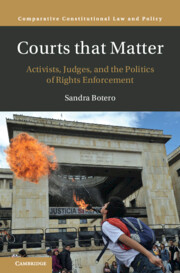Book contents
- Courts that Matter
- Comparative Constitutional Law and Policy
- Courts that Matter
- Copyright page
- Contents
- Figures
- Tables
- Acknowledgments
- 1 Introduction
- 2 Coproducing Judicial Impact
- 3 Collaborative Oversight Arenas
- 4 Assessing the Effects of Monitoring Mechanisms and Legal Constituencies
- 5 Low Impact Cases
- 6 Collaborative Monitoring in India
- 7 Conclusions
- Appendices
- References
- Index
4 - Assessing the Effects of Monitoring Mechanisms and Legal Constituencies
Published online by Cambridge University Press: 02 November 2023
- Courts that Matter
- Comparative Constitutional Law and Policy
- Courts that Matter
- Copyright page
- Contents
- Figures
- Tables
- Acknowledgments
- 1 Introduction
- 2 Coproducing Judicial Impact
- 3 Collaborative Oversight Arenas
- 4 Assessing the Effects of Monitoring Mechanisms and Legal Constituencies
- 5 Low Impact Cases
- 6 Collaborative Monitoring in India
- 7 Conclusions
- Appendices
- References
- Index
Summary
Chapter 4 presents case studies of the impact of four landmark socioeconomic rights rulings. Each pair of case studies seeks to uncover the influence that one of two elements can have on judicial impact: court-promoted monitoring mechanisms and the presence of legal constituencies. The first pair of cases explores the aftermath of rulings that have dense legal constituencies but no court-promoted oversight mechanisms: First, Causa Verbitsky in Argentina, a decision in which the court safeguarded the rights of inmates in the Buenos Aires Province. Second, C-383 1999 in Colombia, a decision in which the court safeguarded the right to housing of Colombian mortgage debtors. The second paired comparison looks at two structural rulings in which monitoring mechanisms were put in place but where there were low density legal constituencies. The first case in this pair is Causa Badaro in Argentina, a decision in which the court protected the right to pension of Argentine seniors earning above 1,000 Argentine pesos. The second case is T-547 2010 in Colombia, a decision in which the court protected the right to prior consultation of the Indigenous people of the Sierra Nevada in Santa Marta.
Keywords
- Type
- Chapter
- Information
- Courts that MatterActivists, Judges, and the Politics of Rights Enforcement, pp. 85 - 128Publisher: Cambridge University PressPrint publication year: 2023



